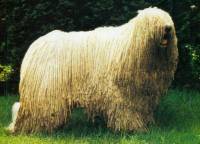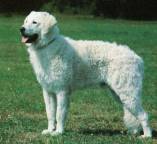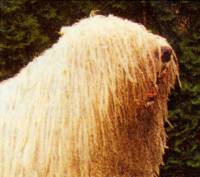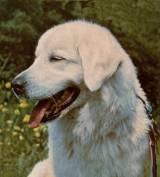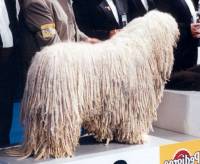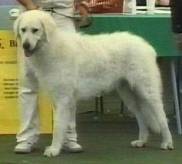The Komondor and Kuvasz
 Kuvasz in Hungary 1996
Kuvasz in Hungary 1996
Hungary has two distinctly different breeds of Livestock Guardian Dogs which evolved independently. The Komondor was developed by a race of people called the Cumans who called their dog the 'Kuman-dor'[3]. Meanwhile Hungary was already settled by the Magyars, a different race. For much of Hungary's early history, these two peoples lived in separate areas in Hungary, spoke different languages and so did not mix. So their dogs were never interbred[4]. Today we have the two separate breeds with their coats being their most distinguishing feature.
History of the Komondor
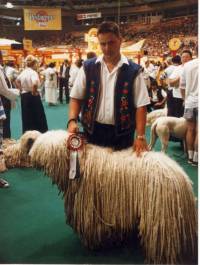 Komondor in Hungary 1996
Komondor in Hungary 1996
The Komondor belonged to a race of people called the Cumans or Kuns who originated in what is now China and migrated westwards to avoid the unrest happening there at that time. They arrived in Hungary and were allowed to settle, the word 'Kun' or 'Hun' remaining today in many Hungarian place names. There is no doubt that the South Russian (Ukrainian) Sheepdog had an influence on the development of the Komondor's extraordinary coat which in turn has influenced the coat of the sheepdog with which it works, the Puli.
Temperament of Livestock Guardian Dogs
 Komondor
Komondor
His temperament is typical of a courageous Livestock Guardian Dog and must always be respected despite his outwardly dignified deportment. The Breed Standard describes his courage and suspicious nature in defence of his herds as well as his property and home of his master. Typical of a Livestock Guardian Dog, he attacks silently if necessary, regarding his territory as his own property and will not tolerate any other living creature in it. During the day, he likes to keep a lying position enabling him to control his area. At night, he is always on the move.
History of the Kuvasz
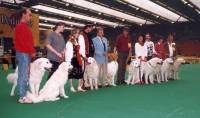 Group of Kuvasz 1996
Group of Kuvasz 1996
The Kusavz is the Livestock Guardian Dog of another race, the Magyars and has an ancestry quite separate from that of the Komondor. There is a believable theory that the name Kuvasz is as a modern corruption of the name 'Ku Assa', a dog originating from Sumeria (part of ancient Mesopotamia)[1].
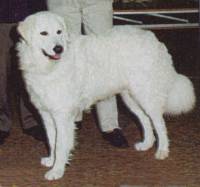 Kuvasz
Kuvasz
However, there are linguists who dispute this theory and believe the the Magyars' language is more similar to peoples in the East and the fact these names are so similar is merely co-incidental. No matter where the Magyars came from, there is no dispute that the other Livestock Guardian Dog of Hungary the Kuvasz, is the ancestor of many other breeds of white Livestock Guardian Dogs of Asia and Europe with its first Breed Standard dating back to 1883[2].
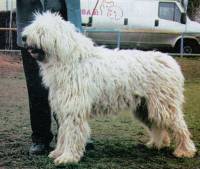 Young Komondor
Young Komondor
Comparison between the Komondor and Kuvasz
The main difference between these two breeds is the coat. The Kuvasz has a moderately harsh medium length double coat with coarse wavy topcoat and fine downy undercoat which is short on the head, ears, feet and legs with longer feathering on the backs of the legs, ruff and tail.
 Komondor Coat
Komondor Coat
However, the Komondor has a corded coat which develops as the dog matures. It is essentially a double coat, the undercoat and topcoat of which are intertwined into thick dense cords.
The cords are longest on the croup and loin where the coat reaches at least 20 - 27 cms (8 - 10.6 inches). On the back, chest and shoulder blades the cords are shorter 15 - 22 cms (6 - 8.5 inches) on the head, ears neck and limbs 10 - 18 cms (4 - 7 inches) and even shorter still at the lips and around the lower limbs 9 - 11 cms (3.5 - 4.3 inches). The shorter tufts of hair are less matted. A combed out coat or one that is neglected is undesirable.
|
Komondor |
Kuvasz |
|
|---|---|---|
|
|
|
|
|
Colour |
Ivory coat covering a slate grey, well pigmented skin contrasting with the black lips nose and eye rims, the dark pigment extending to the gums and the roof of the mouth. |
White coat but ivory permitted, the skin being slate grey contrasting with the black lips nose and eye rims, the dark pigment extending to the gums and the roof of the mouth. |
| Size |
Height: Dogs: Min 70 cm (27.7 in) Weight: 50 - 60 kg (110 - 132 lbs) |
Height: Dogs: 71 - 76 cm (28 - 30 in) Weight: Dogs: 48 - 62 kg (106 - 137 lbs) |
|
Head |
The broad head is proportion to the body. It has a domed skull, well developed brows and stop. The muzzle is strong but cut off bluntly and the black lips have jagged edges. The nose is black. |
The broad head is wedge shaped, the slight dome and stop with distinct furrow makes the forehead protrude slightly. The muzzle is strong but cut off bluntly, the black lips have jagged edges. The nose is black. |
|
Eyes |
The eyes set on a horizontal plane and the eye rims are black. |
The eyes are oval and set slightly slanting and the eyes rims are black.
|
|
Ears |
The ears are set on fairly high and are either V or U shaped. They are dropped with no lift, even when alert. |
The ears V-shaped set on at medium height but can lift away from the base when alert. |
|
Mouth |
Normal scissors bite with full dentition |
Normal scissors bite with full dentition |
|
|
|
|
|
Neck |
Fairly short and muscular and carried slightly elevated at rest but horizontal on the move but with no neck ruff or dewlap. |
Fairly short and muscular and carried at slightly elevated but horizontal on the move. There is no dewlap but there is a collar or mane of hair around the neck especially in males. |
|
Body |
The broad, well-muscled body is slightly longer than its height at withers which are clearly defined above the level of the back. The chest is broad and deep and very well muscled.The chest is of medium depth and the underline is only slightly tucked up. The loin and the slightly sloping croup are both of medium length. |
The body forms a prone rectangle. The withers rise markedly above the level of the back. The forechest, is rounded and slightly protruding. The chest is deep, long and the underline is tucked up. The loin is short, the croup is slightly sloping, well muscled and broad. |
|
Tail |
The tail is set on low but when alert, it can be raised to the level of the back. It should reach the hock, the tip showing a slight bend upwards. |
The tail is set on low but when alert, it can be raised to the level of the back. It is usually carried vertically down with the tip curved slightly upwards. |
|
|
|
|
|
Feet |
The fore feet are large and strong with slate grey pads and grey toenails. The hind feet are similar but longer than the forefeet. Any dewclaws are to be removed. |
The feet are round or slightly oval and taut, the middle toes being short and highly arched. The pads are black with the nails black or slate grey. |
|
Gait |
He moves with a wide well-covering trot with balanced reach and drive. |
He moves with wide, slow steps, the movement being light footed, springy, ground covering, lively, constant and tireless. |
References and Further Reading
[1] Edward S Bordeaux, "Messengers from Ancient Civilizations" Academy Books San Diago, CA pub 1974
[2] Dr Lajos-Orkeny Hudak, "Csaba-Geczi, Imre-Hodosi, Jozef-Vad, Laszlo", Edited by Hodosi, Jozsef, Revised by Kovacs, Dr Andras, English Translation by Farago, Otto & Edited by Dash Gail. The Kuvasz, Gail S Dash P.O. Box 280322, Northridge CA 91328, 2000. See also http://kuvaszinfo.com/kovacs.htm
[3] Andras Paloczi Horvath, "Pechenegs, Cumans, Iasians, Steppe peoples in medieval Hungary", Corvina Kiado, 1989
[4] Dr. Arthur R. Sorkin http://www.komondor.org/html/history.html
